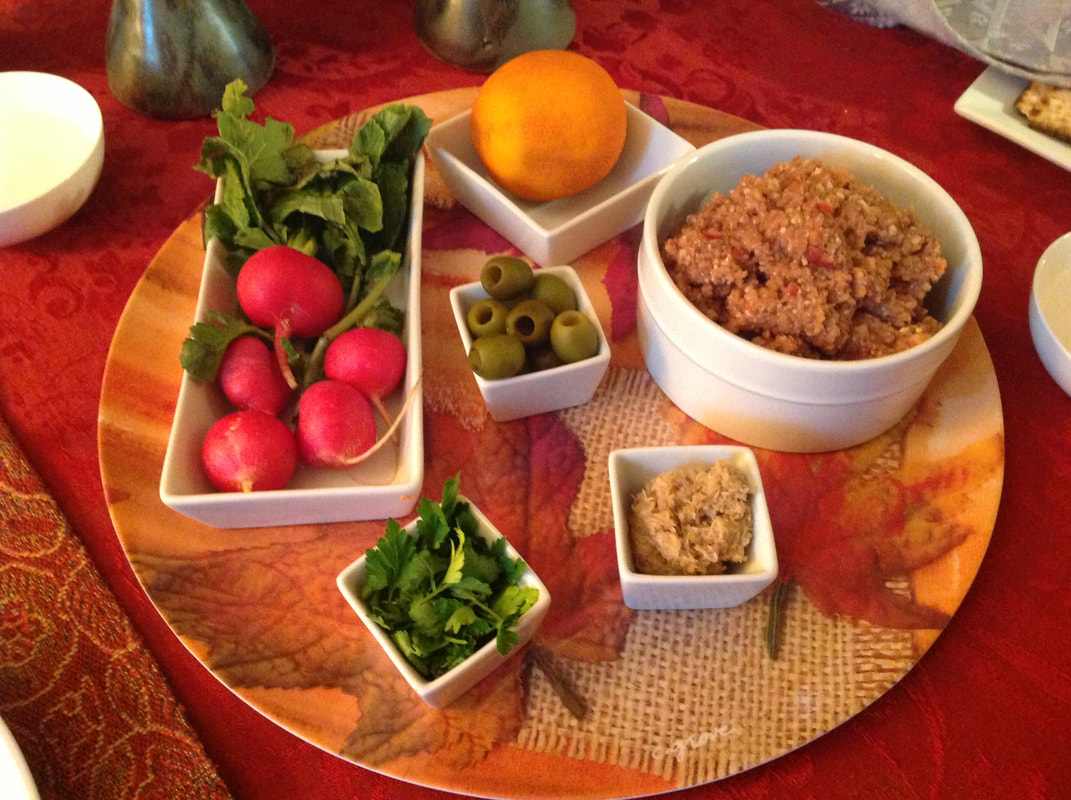Return to Newsletter main page! |
Expanding the Seder PlateBy ISJL Education Fellow Josh Altshuler
Pesach (Passover) consistently figures as one of the most popular festivals in the Jewish calendar. It is not just dense matzah kugel, afikoman (dessert) search parties, and conversations about Exodus that feed Passover’s legacy. Traditions inscribed in the Hagadah—the central text that serves as a foundation for the Seder—energize family and friends as they engage with the historical and cultural fabric of the Jewish community. Conventional emblems like the egg, salt water, and charoset (mortar) embody the narrative of enslavement in Egypt. These days, many communities use additional or alternative objects and rituals to involve marginalized and disregarded voices on Passover. Consider adopting these innovative spiritual symbols and amended practices for the upcoming holiday. An Orange on the Seder Plate The orange’s vibrant color and texture is a testament to the feminist and LGBTQ+ movements’ passionate history. According to Ritualwell: “In the early 1980s, while speaking at Oberlin College Hillel, Susannah Heschel was introduced to an early feminist hagadah that suggested adding a crust of bread on the seder plate, as a sign of solidarity with Jewish lesbians (there's as much room for a lesbian in Judaism as there is for a crust of bread on the seder plate). Heschel felt that to put bread on the seder plate would be to accept that Jewish lesbians and gay men violate Judaism like chametz violates Passover. So, at her next seder, she chose an orange as a symbol of inclusion of gays and lesbians and others who are marginalized within the Jewish community. She offered the orange as a symbol of the fruitfulness for all Jews when lesbians and gay men are contributing and active members of Jewish life.”[i] The orange makes Pesach more relevant as guests consider how gender and identity are implicated in contemporary injustices. Peeling Away at a Pinecone Some seders reflect on the prickliness of the pinecone. Due to its mundane nature, the pinecone is “passed over” every day. Yet, hidden within it are valuable pine nuts, nearly impossible to extract from the pinecone’s coarse, sharp exterior. The precious nuts, as a result, are overlooked. The prison correctional system acts similarly. Members of society often pass near prisons without considering the individuals incarcerated beyond cement walls and fences. These prisoners, disproportionately African-American, are isolated from relationships, accessing progress, and fulfilling identity. Social inequality, racism, and delayed legal reforms make mass incarceration even harder to combat. The inclusion of a pinecone on Passover recommits gathered guests to the perpetual fight for criminal justice and supporting the buried voices beyond apathetic institutions.[ii] Vegetarians Invited The traditional seder plate highlights a few items that do not reflect the life choices of vegans and vegetarians. The z’ro-ah (shank bone), for example, signifies the Passover sacrifice, which saved the Israelites during the tenth plague. However, some vegetarian attendees might object to this presentation of an animal. One of the most common substitutions for z’ro-ah is a red beet. Beets naturally bleed like the paschal lamb and, thereby, exhibit the Passover offering. The beitzah or egg also is a standard member of most Passover commemorations. The egg also represents the Pesach sacrifice, but likewise harkens to the coming of springtime, fertility, and life cycles. Although less practiced, a budding flower could replace the egg. Flowers bloom in the spring, and they participate in renewal by spreading pollen and seeds. Finally, conversations around sustainability and environmental advocacy bring important issues that concern vegetarians and vegans to the table.[iii] Sober Seder As is the case during other Jewish festivals, the consumption of alcohol has a scripted role on Passover as most adult participants drink four cups of wine throughout the evening. The four cups recall the liberation from Egypt and the concept of redemption. But as wine takes up a sacred place in Seder practice, people living with alcoholism and addiction are alienated. The four cups of wine separate this community and their families from engaging fully with Judaism and disregard the profound struggle of combating alcoholism. Sober Seders are gradually becoming a more welcome alterative. These rituals embrace all the major themes and customs of Passover save the recurrent drinking of wine. This amendment inspires a more caring and thoughtful spiritual environment where guests living with addiction are supported and their stories are acknowledged. Each of these modifications to the prototypical Passover observance conveys a willingness to address the needs and characters of all communities. These alternations do not necessarily have to change the face of the Seder plate but can act as a guide for more welcoming and energizing discussion and a greater impetus to take action outside the pages of the Hagadah. [i] https://www.ritualwell.org/ritual/orange-seder-plate [ii] http://www.tisrael.org/wp-content/uploads/2017/03/Passover-Pinecone-Booklet-FINAL.pdf [iii] https://www.thekitchn.com/the-passover-seder-plate-and-n-48111 |
- Home
- WHO WE ARE
-
WHAT WE DO
- PODCAST
- Conference >
- Education >
-
CULTURE
>
- Culture Overview
- Cultural Programming >
-
History
>
-
Encyclopedia of Southern Jewish Communities
>
- Alabama Encyclopedia
- Arkansas Encyclopedia
- Georgia Encyclopedia
- Florida Encyclopedia
- Kentucky Encyclopedia
- Louisiana Encyclopedia
- Mississippi Encyclopedia
- North Carolina Encyclopedia
- Oklahoma Encyclopedia
- South Carolina Encyclopedia
- Tennessee Encyclopedia
- Texas Encyclopedia
- Virginia Encyclopedia
- Encyclopedia Credits
- Oral History
-
Encyclopedia of Southern Jewish Communities
>
- SPIRITUALITY >
- DONATE
- Shalom Y'all
- Strategic Plan
- Southern & Jewish Blog
- Calendar
- Virtual Press Kit
|
©2024 Goldring/Woldenberg Institute of Southern Jewish Life
|

